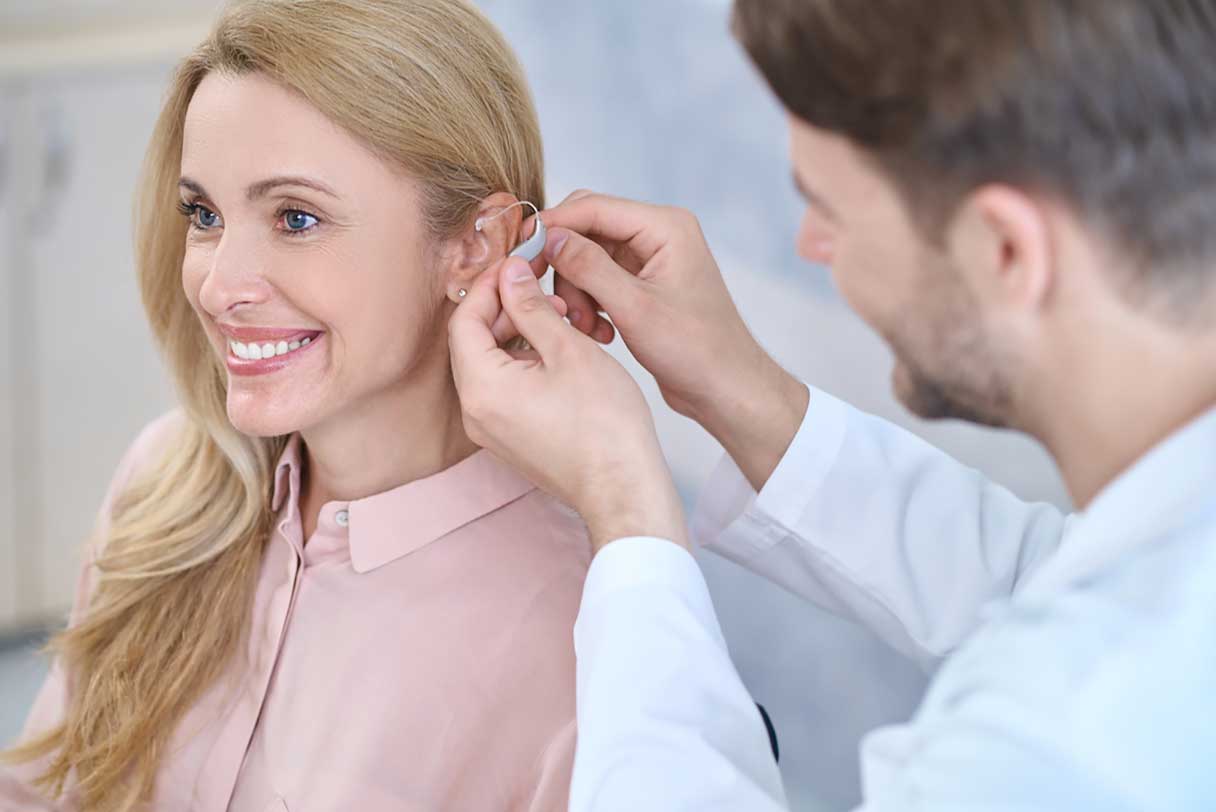Hearing aids can be a lifeline for millions of Americans, yet they remain surprisingly underused. Although more than 28 million adults in the United States could benefit from hearing aids, only about 30% of adults ages 70 and older and only around 16% of adults ages 20 to 69 take advantage of them.1
For people looking to correct certain types of hearing loss or who do not respond well to traditional hearing aids, bone-anchored hearing aids (BAHA) may be a good option.
What Is a Bone-Anchored Hearing Aid (BAHA)?
A bone-anchored hearing system is a small, surgically implanted titanium device that is placed in a small bone behind the ear, attaching to an external processor worn behind the ear. There are also non-surgical types of BAHA devices.2
People with conductive hearing loss typically benefit from a BAHA device. Other common reasons someone may need a BAHA device include:2
- Allergy to traditional hearing aids
- Benign tumor
- Chronic ear infections
- Severe malformations of the outer or middle ear
- Single-sided deafness
How Does a Bone-Anchored Hearing Aid Work?
The BAHA corrects hearing loss by transmitting sound vibrations directly from the environment to the inner ear, bypassing the outer and middle ear altogether. This is achieved through bone conduction, which occurs through the skull.2
Types of bone-anchored hearing aids
There are two types of bone-anchored hearing aids: non-surgical and surgical implantation.2
- Non-surgical bone conduction hearing devices are attached using a headband, a softband or an adhesive that attaches directly to the skin. These are typically good for small children and people who do not want to undergo surgery.2
- Surgically implanted BAHA implants a small screwlike device in direct connection with the skull. An external processor connects magnetically with the implant to allow vibration signals to reach the inner ear.2
BAHA vs. conventional hearing aids
One of the biggest differences between BAHA and conventional hearing aids is the type of hearing loss they correct.
Bone-anchored hearing aids are designed to treat conductive hearing loss, which is caused by damage to the outer or middle ear. The BAHA device is attached directly to the skull bone, which allows sound vibrations to travel via bone conduction to the cochlea in the inner ear and up the auditory pathway to the brain.2
In contrast, conventional hearing aids use air conduction to amplify sound waves along the direct pathway from the middle ear to the inner ear. They are most often used to treat sensorineural hearing loss, which is caused by damage to the inner ear or neural pathway.3
How Much Does a Bone-Anchored Hearing Aid Cost?
The national average cost* for a percutaneous BAHA implant (which has a small abutment sticking out through the skin for attaching the processor) is $11,601, but it can range from $9,259 to $21,864. The average cost* for a transcutaneous BAHA implant (completely under the skin) is $13,854, but it can range from $10,670 to $24,674. In comparison, the average cost* of conventional digital hearing aids per pair ranges between $1,650 and $4,155.4
The variables that can affect cost include:4
- Brand and type of hearing system
- Clinic location and specialist expertise
- Follow-up and programming sessions
- Maintenance and replacement parts
- Surgical and fitting costs
Calculate the costs of a bone-anchored percutaneous implant near you*

Explore procedure costs in your area
Average cost of bone-anchored hearing aids by state/district
Here is a breakdown of the average costs* of a BAHA device across all 50 states and the District of Columbia:4
| State/District | Average cost of percutaneous BAHA | Average cost of transcutaneous BAHA |
|---|---|---|
| Alabama | $10,015 | $11,870 |
| Alaska | $14,031 | $16,805 |
| Arizona | $11,700 | $14,019 |
| Arkansas | $10,399 | $12,048 |
| California | $14,274 | $17,186 |
| Colorado | $11,564 | $13,723 |
| Connecticut | $11,936 | $14,301 |
| Delaware | $11,576 | $13,797 |
| District of Columbia | $15,679 | $17,546 |
| Florida | $11,469 | $13,787 |
| Georgia | $10,535 | $12,419 |
| Hawaii | $17,414 | $20,673 |
| Idaho | $11,725 | $14,138 |
| Illinois | $12,246 | $13,975 |
| Indiana | $10,176 | $12,611 |
| Iowa | $10,101 | $11,930 |
| Kansas | $10,225 | $12,256 |
| Kentucky | $10,771 | $12,522 |
| Louisiana | $10,771 | $12.997 |
| Maine | $11,378 | $14,093 |
| Maryland | $13,274 | $15,664 |
| Massachusetts | $12,903 | $17,872 |
| Michigan | $10,659 | $12,745 |
| Minnesota | $10,796 | $12,923 |
| Mississippi | $10,263 | $11,989 |
| Missouri | $10,312 | $12,434 |
| Montana | $11,341 | $13,649 |
| Nebraska | $10,300 | $12,434 |
| Nevada | $11,663 | $14,049 |
| New Hampshire | $12,047 | $14,316 |
| New Jersey | $12,890 | $15,027 |
| New Mexico | $10,622 | $12,656 |
| New York | $12,952 | $15,220 |
| North Carolina | $10,709 | $12,760 |
| North Dakota | $10,597 | $12,671 |
| Ohio | $10,833 | $12,967 |
| Oklahoma | $9,916 | $11,900 |
| Oregon | $12,481 | $14,953 |
| Pennsylvania | $11,329 | $13,426 |
| Rhode Island | $12,382 | $14,508 |
| South Carolina | $10,523 | $12,893 |
| South Dakota | $10,696 | $12,463 |
| Tennessee | $10,585 | $12,508 |
| Texas | $10,808 | $12,764 |
| Utah | $11,477 | $14,123 |
| Vermont | $11,626 | $14,167 |
| Virginia | $11,304 | $13,501 |
| Washington | $12,865 | $15,042 |
| West Virginia | $10,325 | $12,300 |
| Wisconsin | $10,895 | $12,952 |
| Wyoming | $10,783 | $12,641 |
Does Insurance Cover Bone-Anchored Hearing Aids?
Hearing aids, including BAHA devices, are typically covered by health insurance.2 However, out-of-pocket costs will vary depending on insurance type (personal insurance, Medicare, Medicaid).
The Centers for Medicare and Medicaid Services has revised its definition of hearing aids to include auditory osseointegrated and auditory brainstem implant devices and related services to ensure they are covered under Medicare as prosthetic devices.5
Bone-Anchored Hearing Aid Procedure
The BAHA device consists of two parts: the internal implant and the external processor. Together, they create a bone conduction pathway allowing sound vibrations to be translated through the bone instead of the middle ear.2
Your doctor may have you try the non-surgical option for a few weeks to see if this type of hearing aid is right for you.2
Surgical implantation
Placing the small titanium implant in the bone behind your ear is an outpatient surgical procedure.3 It is typically performed under local or general anesthesia.6
An incision will be made in the skin behind the ear, and a tiny hole will be drilled into the mastoid bone to accommodate the implant. The incision is closed with stitches, and a dressing is applied to keep it clean and dry.6
You will need to wait several weeks for the implant to fuse with the bone before the external processor attachment can be used to correct hearing. This process is called osseointegration.3
Recovery
Recovery from surgery usually takes about a week. You may experience soreness or redness.6 Call your doctor if you develop a fever or experience long-lasting ear pain.
Activation and programming
After osseointegration is complete, a doctor or audiologist will help fit the external processor to the implant and customize its settings to meet your specific needs.7
These steps can include:
- Calibrating to minimize feedback7
- Customizing listening programs for both quiet and loud environments7
- Personalizing the settings7
- Positioning the processor for optimal sound transmission
- Training you on how it works
- Volume control
After activation, follow-up appointments may be necessary to fine-tune or troubleshoot any complications and to ensure optimal hearing.2
How to Know if a BAHA Is Right for You
The bottom line is that if traditional hearing aids don’t work for you, or you have conductive hearing loss with damage to your middle ear, a BAHA device might be right for you.
While BAHA may be more expensive than traditional hearing aids, they are typically covered by insurance and can be a more convenient solution for ensuring your hearing loss does not affect your quality of life.
Frequently Asked Questions About BAHA
Still have questions about bone-anchored hearing aids? Here are answers to some commonly asked questions about them.
Financing Ear Care With the CareCredit Credit Card
The CareCredit credit card can help you pay for hearing care, including regular hearing tests, screenings and more.** Use our Acceptance Locator to find a hearing specialist near you that accepts CareCredit. Continue to invest in your wellness journey by downloading the CareCredit Mobile App to manage your account, find a provider on the go and easily access the Well U blog for more great articles, podcasts and videos.
In addition to hearing care, you can also use your CareCredit credit card for dentistry, cosmetic, pet care, vision, health systems, dermatology, pharmacy purchases, spa treatments and so much more within the CareCredit network. How will you invest in your health and wellness next?
Author Bio
Amy Isler, M.S.N., R.N., has more than a decade of nursing expertise. She combines her nursing experience and journalism background to create engaging and educational healthcare content for leading brands and publications, including GoodRx, Verywell Health, Vision Center and more. Her mission in writing is to provide positive, accurate and informative articles for consumers.






